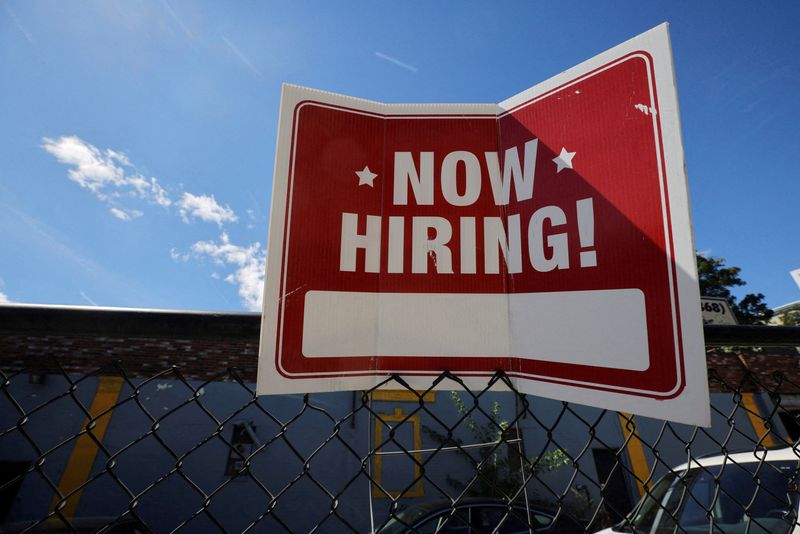By Lucia Mutikani
WASHINGTON (Reuters) - U.S. employers maintained a strong pace of hiring in March, pushing the unemployment rate back down to 3.5% and signaling labor market resilience that will keep the Federal Reserve on track to raise interest rates one more time next month.
The Labor Department's closely watched employment report on Friday showed that annual wage gains slowed but remained too high to be consistent with the U.S. central bank's 2% inflation target. The release capped a week dominated by data, including upward revisions to the weekly state unemployment and continuing claims, that had suggested labor market conditions were easing.
Labor market tightness is drawing more people into the workforce, with 480,000 entrants last month, which could help to further restrain wage growth. The unemployment rate for Blacks dropped to an all-time low of 5.0%.
"Rather than an abrupt and jarring end to the jobs party of the past couple of years, the nation's job market is instead gradually turning the lights back up and music down in a mostly smooth transition from weekend to weekday that looks, for now, to be largely sustainable and healthy," said Nick Bunker, head of economic research at the Indeed Hiring Lab.
Nonfarm payrolls increased by 236,000 jobs last month, the survey of establishments showed. Data for February was revised higher to show 326,000 jobs added instead of the previously reported 311,000. Job growth averaged 345,000 per month in the first quarter, more than triple the pace needed to keep up with growth in the working-age population.
Some of the slowdown in hiring reflected the fading boost from unseasonably mild weather in January and February.
Economists polled by Reuters had forecast payrolls would rise by 239,000. Estimates ranged from 150,000 to 342,000.
The leisure and hospitality industry accounted for the bulk of the employment gains, adding 72,000 jobs, most of those positions at restaurants and bars. Employment in the leisure and hospitality sector remains 368,000 jobs below its pre-pandemic level.
Restaurants and bars have been the main drivers of job growth since the recovery from the pandemic.
Government employment increased by 47,000. Employment in the government sector is 314,000 jobs below its February 2020 level. There were increases in professional and business services hiring, as well as in healthcare, transportation and warehousing. But manufacturing payrolls fell for a second straight month. Retailers shed 14,600 jobs, while construction employment decreased by 9,000.
While last month's job gains sketched a picture of an economy that continues to expand, the risks are mounting. Credit conditions have tightened following the failure of two regional banks in March, which could make it harder for small businesses and households to access funding.
Business sentiment is at recessionary levels and consumer confidence remains lackluster. Economists expect the labor market to loosen up considerably starting in the second quarter as companies respond more to slowing demand caused by the higher borrowing costs.
For now, the labor market is not collapsing. Average hourly earnings rose 0.3% in March after gaining 0.2% in February. In the 12 months through March, wages increased 4.2% after rising 4.6% in the 12 months through February. Annual wage growth is slowing as last year's large increases drop out of the calculation.
The dollar edged higher against a basket of currencies, while U.S. Treasury prices climbed. The U.S. stock market was closed for the Good Friday holiday.
STRONG DATA
The average workweek fell 0.1 hour to 34.4 hours, reflecting a decrease in the goods-producing industry. The shorter workweek together with a drop of 10,700 positions in temporary help employment likely portends slower job gains ahead.
Fed officials will now await inflation data later this month to gauge the impact of their year-long monetary policy tightening campaign.
"There was certainly nothing in today's report to raise concerns about near-term recession risks," said Michael Feroli, chief U.S. economist at JPMorgan (NYSE:JPM) in New York. "We continue to look for a 25-basis-point hike at the May meeting, followed by an extended pause. We see some risk of another hike in June."
Financial markets are leaning toward the central bank increasing rates by another 25 basis points at the May 2-3 policy meeting, according to CME Group's (NASDAQ:CME) FedWatch tool.
The U.S. central bank last month raised its benchmark overnight interest rate by a quarter of a percentage point, but indicated it was on the verge of pausing further rate increases in a nod to financial market stress. It has hiked its policy rate by 475 basis points since last March from the near-zero level to the current 4.75%-5.00% range.
Details of the household survey from which the unemployment rate is derived were upbeat. The jobless rate is back at more than a 50-year low, having declined from 3.6% in February.
The drop in the Black unemployment rate was the largest since September 2021 and pushed it to the lowest level since 1972, when the government started tracking the series. The decrease from 5.7% in February was driven by women.
"This is good news in and of itself, and also a reassuring signal for the business cycle since Black Americans have historically been last to see their unemployment rate fall during expansions and the first to see it increase in recessions," said Bill Adams, chief economist at Comerica (NYSE:CMA) Bank in Dallas.
Household employment increased by 577,000 jobs. Even more encouraging, the labor force participation rate, or the proportion of working-age Americans who have a job or are looking for one, climbed to 62.6% from 62.5% in February. The participation rate for Blacks rose to the highest level since 2008.

The employment-to-population ratio, viewed as a measure of an economy's ability to create employment, increased to 60.4% from 60.2% in the prior month. The share of those aged 25 to 54 with a job hit 80.7%, the highest level since May 2001.
"Time will tell if tighter credit conditions slow the economy down in the months to come," said Christopher Rupkey, chief economist at FWDBONDS in New York.